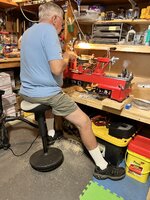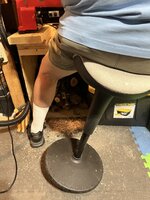The Texas Penwright
Member
My brother-in-law is excellent on a lathe; he has helped me fill orders many times. Unfortunately, he has a serious issue with one knee, so standing at the lathe is becoming a bigger and bigger problem for him. That's too bad because he really loves creating some excellent pieces.
I was wondering if there are any of you that know if it would be possible to work a lathe (his is a 14" lathe) while being seated? If so, what modifications of the workspace are generally required? (Photos maybe?) I've tried sitting on a tall stool and working sometimes (when I'm tired), but it never really felt very comfortable.
All input appreciated, and thanks. --James
I was wondering if there are any of you that know if it would be possible to work a lathe (his is a 14" lathe) while being seated? If so, what modifications of the workspace are generally required? (Photos maybe?) I've tried sitting on a tall stool and working sometimes (when I'm tired), but it never really felt very comfortable.
All input appreciated, and thanks. --James




